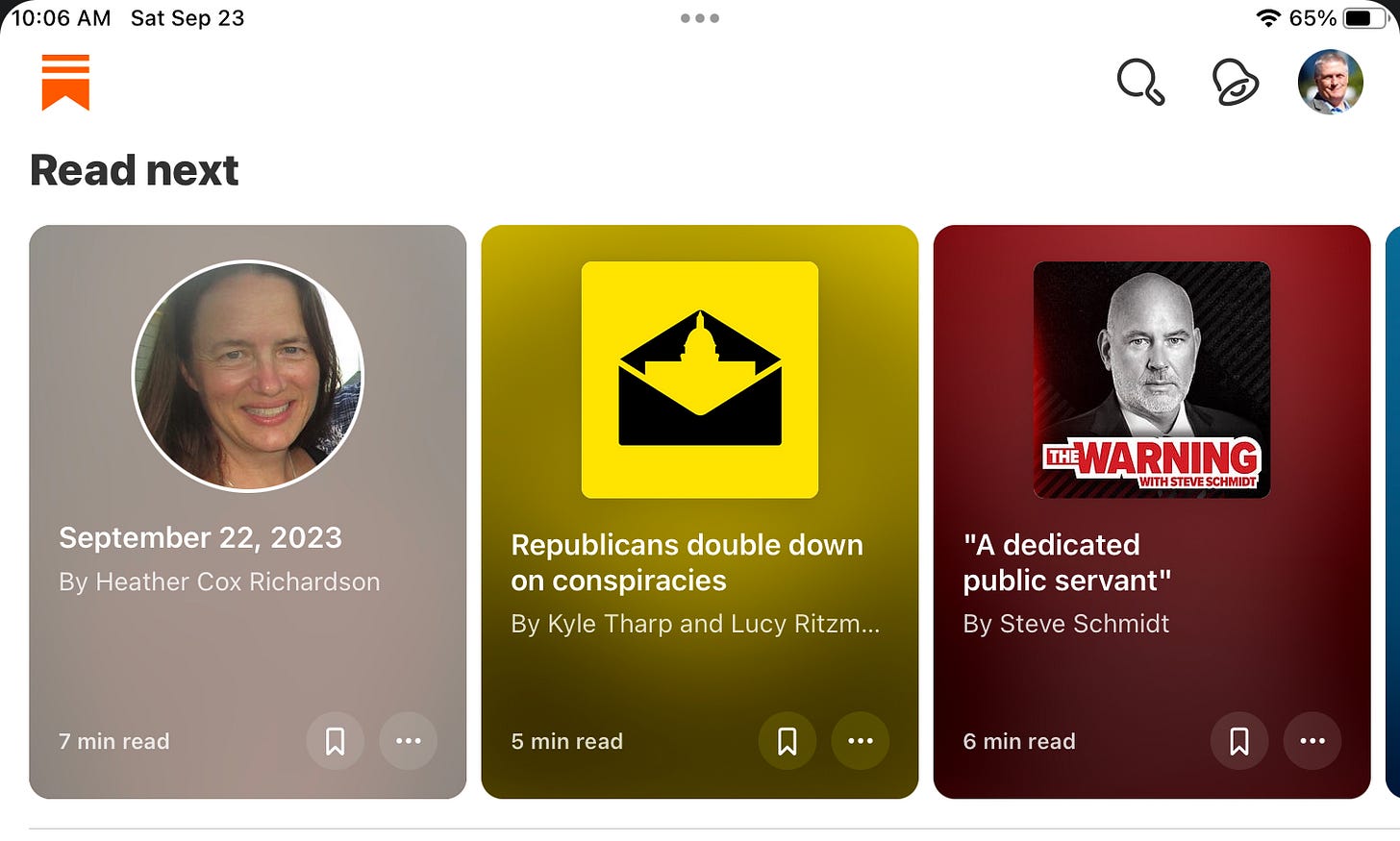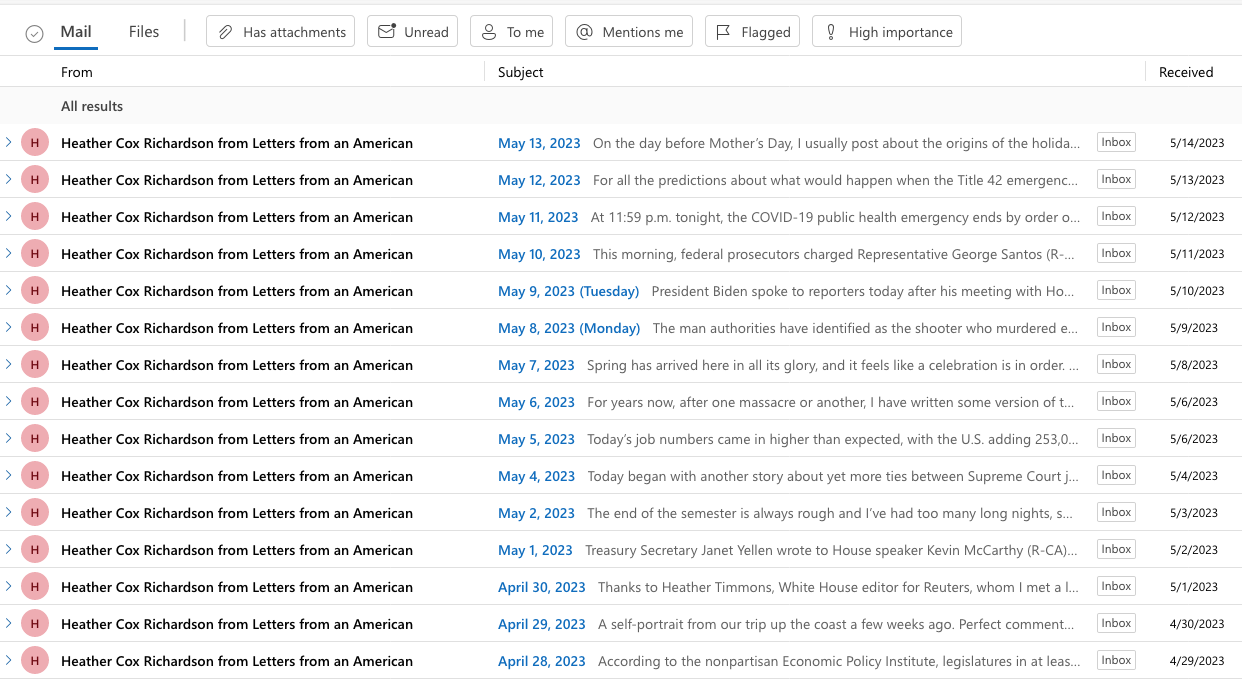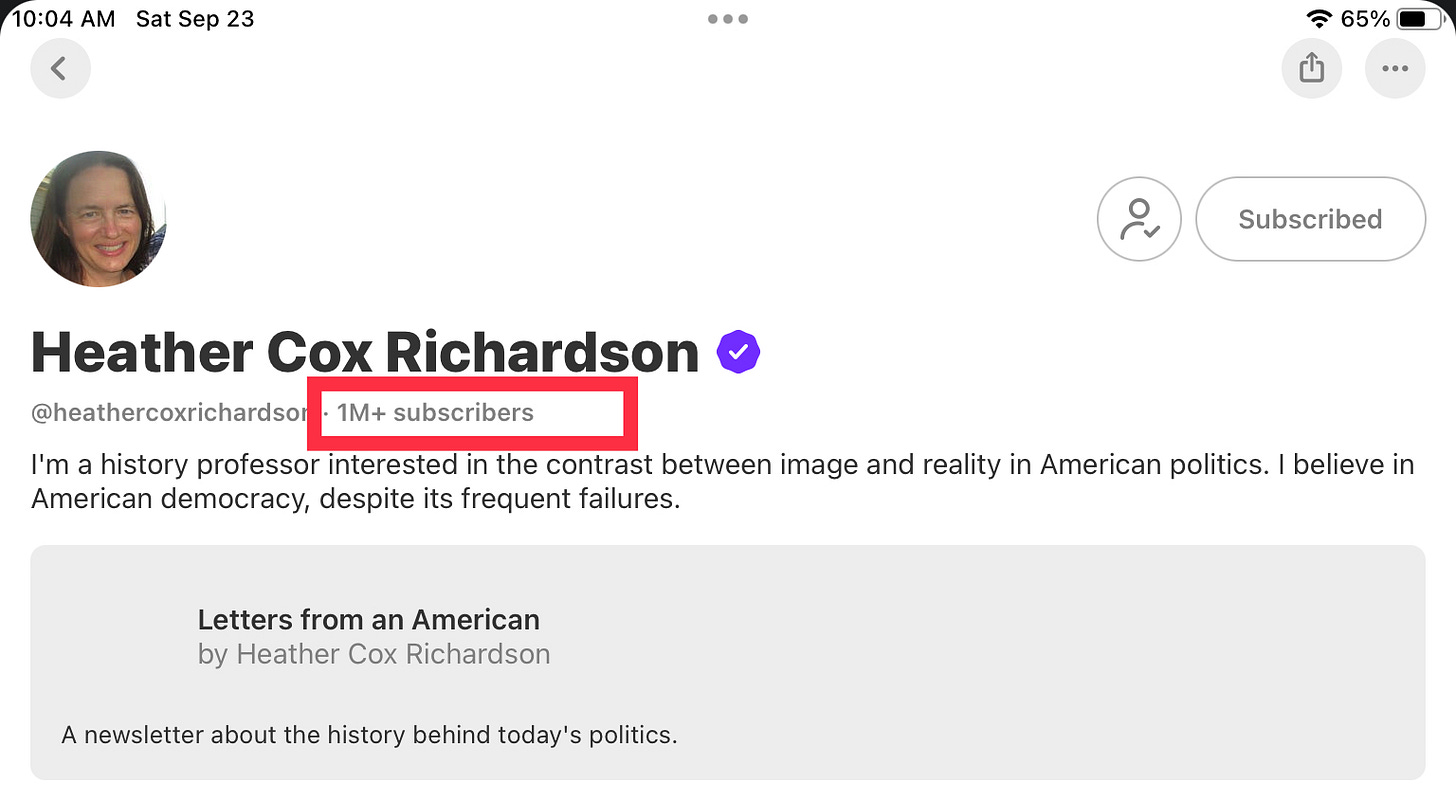A Newsletter Subject Line Tactic I Would RARELY Recommend
What is a glaring mistake for 99% of newsletters works for this one. Plus digital marketing news, Music Monday & Glorious Midjourney Mistakes.

There are so many good newsletters on Substack!
One of them I subscribe to is
by , who has published six books of American history, among them The Death Of Reconstruction, How the South Won the Civil War, and her new book to be released on the Tuesday, Democracy Awakening.I highly recommend her newsletter and look forward to reading her new book.
I mention her newsletter because as I was scrolling through the Substack app this weekend, it struck me that Richardson uses a naming convention for each edition of her newsletter that 99% of the time I would never recommend. The title of each edition of her newsletter is simply the date on which she presses Send.
I see this all the time with newsletters and there’s no need for it because subscribers’ inboxes already tell you the date an individual edition was sent. Here’s how Richardson’s newsletter looks in substack:
And here’s how it looks in my inbox:
As you can see, Richardson uses the publish date as the title of each edition but as you can also see, my inbox has a Received column which displays that very same date. Redundant.
The greatest factor that determines whether someone opens an email is whether or not the sender is known to them. In the case of newsletters, that’s not an issue because subscribers know the sender by virtue of the fact that they subscribed to the newsletter.
The second most important factor that determines whether or not someone opens an email is the subject line. The text that follows the date in the subject line is preview text. You can set that manually in Substack but if you don’t it will use the first line of text in your newsletter.
I’ve seen too many newsletters to count include the date and the name of the newsletter in the subject line, two pieces of information the recipient already knows. This does nothing to persuade the subscriber to actually open the email and read the newsletter. The subject line and the preview text should work hand-in-hand to do just that.
Another downside to naming your newsletter editions in this way is that it provides no hint of the content when someone wants to share it on social media. This is what it looked like when I went to share an article to LinkedIn via Buffer:
If I wanted to give my followers an idea of what I was sharing, I’d have to come up with my own headline for the article.
Richardson does not use the subject line to tease the contents of the newsletter. And yet it works for her. Why?
First, she’s an extremely popular historian, so she’s already got a huge existing and devoted audience. Here are the numbers:
Her yet-to-be-released new book is already a best seller on Amazon due to pre-orders,
Her newsletter boasts two million readers,
She has 1.7 million followers on Facebook,
41,600 Instagram followers,
25,800 Threads followers,
52,200 YouTube subscribers, and
384,300 Twitter followers (dormant).
She’s got a huge audience that engages with her content:
They need no motivation to read what she has to say.
Finally, using a date as the title for each newsletter edition is consistent with the name of her newsletter: Letters from an American. Letters arrive in your mailbox with a dated postmark!
Digital Marketing News
Advertising
Mashable by Matt Binder - X is no longer labeling ads for some users - Multiple users on X have recently reported advertisements showing up on their feed without any disclosure or labeling. The paid ads being served to users appear as organic posts (aka tweets) and show up like non-paid content, right in a user's feed.
This is illegal, right?
Bloomberg by Matt Day and Jake Rudnitsky - Amazon Prime Video Content to Include Ads Staring Early 2024 - Amazon.com Inc., following other streaming platforms looking to further monetize their content, will run ads on its Prime Video service in key markets – a move that will help offset rising costs and provide a boost to an already robust advertising business.
Ad-supported streaming will be the default on Prime Video in US, UK, Germany and Canada starting early next year, the company said in a statement on Friday. The company has long offered video streaming as part of a package that also includes speedy shipping, music and other perks. Amazon said Prime subscribers will continue to pay $139 annually in the US but will be able to pay an additional $2.99 a month to avoid ads. [Emphasis mine.]
We are headed toward the enshittification stage of the streaming video platforms.
Artificial Intelligence
VentureBeat by Sharon Goldman - Amazon announces new generative AI version of Alexa - “Alexa, let’s chat” — nearly a decade after debuting its voice-activated Echo devices, the e-commerce and cloud juggernaut Amazon today announced that its signature voice assistant Alexa is being upgraded with a new, custom-built large language model (LLM), taking advantage of the generative AI boom in Silicon Valley to give Alexa even more capabilities and human-like conversational qualities.[…]
The new Alexa LLM will be available as a free preview on Alexa-powered devices in the U.S. soon, and Amazon claims it is “smarter, more conversational” and its voice is more “realistic” and “casual.”
I’ve been waiting for this to happen. Smart speakers are about to get a lot more interesting.
Ars Technica by Benj Edwards - The AI-assistant wars heat up with Claude Pro, a new ChatGPT Plus rival - What does Claude have that ChatGPT doesn't? One big difference is a 100,000-token context window, which means it can process about 75,000 words at once. Tokens are fragments of words used while processing text. That means Claude can analyze longer documents or hold longer conversations without losing its memory of the subject at hand. ChatGPT can only process about 8,000 tokens in GPT-4 mode.
I’ve been really impressed with Claude. I’ve been using it to gain insights from technical research papers that can be dense and time-consuming to read. I’ve recently been doing research on an upcoming post on the psychology of the color red for the website design chapter of my book and it correctly cited academic researchers of the topic and let me interrogate what those researchers had to say about the color red. I cross-referenced the titles and authors with Google and they all checked out.
Futurism by Victor Tangermann - Microsoft Publishes Garbled AI Article Calling Tragically Deceased NBA Player "Useless" - Former NBA player Brandon Hunter passed away unexpectedly at the young age of 42 this week, a tragedy that rattled fans of his 2000s career with the Boston Celtics and Orlando Magic.
But in an unhinged twist on what was otherwise a somber news story, Microsoft's MSN news portal published a garbled, seemingly AI-generated article that derided Hunter as "useless" in its headline.
"Brandon Hunter useless at 42," read the article, which was quickly called out on social media. The rest of the brief report is even more incomprehensible, informing readers that Hunter "handed away" after achieving "vital success as a ahead [sic] for the Bobcats" and "performed in 67 video games."
A real-life example of an AI algorithm maligning the reputation of a dead man.
Search Engine Land by Barry Schwartz - Google Search can now validate responses from Bard - Google has updated Bard with a number of features, including the ability to double-check the responses provided by Bard by using Google Search. Google also has extensions for Gmail, Docs, Drive, Maps, YouTube, and Google Flights and Hotels for Google Bard. Bard has expanded Lens integration in 40 new languages and Bard upgraded its PaLM2 model to make it more capable, the company announced.
Can’t wait to see what additional value these extensions can unlock for me from my Gmail account and Google Docs.
VentureBeat by Sean Michael Kerner - Galileo offers new tools to explain why your AI model is hallucinating - San Francisco-based artificial intelligence startup Galileo is aiming to help its users to better understand and explain the output of large language models (LLMs), with a series of new monitoring and metrics capabilities that are being announced today. The new features are part of an update to the Galileo LLM Studio, which the company first announced back in June. Galileo was founded by former Google employees and raised an $18 million round of funding to help bring data intelligence to AI.
Good to know people are working to solve this problem.
Rest Of The World by Andrew Deck - Why Silicon Valley’s biggest AI developers are hiring poets - A string of job postings from high-profile training data companies, such as Scale AI and Appen, are recruiting poets, novelists, playwrights, or writers with a PhD or master’s degree. Dozens more seek general annotators with humanities degrees, or years of work experience in literary fields. The listings aren’t limited to English: Some are looking specifically for poets and fiction writers in Hindi and Japanese, as well as writers in languages less represented on the internet.
The companies say contractors will write short stories on a given topic to feed them into AI models. They will also use these workers to provide feedback on the literary quality of their current AI-generated text.
Revenge of the humanities majors.
Generative AI by Jim Clyde Monge - Dall-E3 Is Here And It’s Mind-Blowing - After ten months of silence, OpenAI has finally released Dall-E3, the latest version of its popular AI image generator. Dall-E3 is said to be a significant improvement with more nuance and details over Dall-E2.
What’s new in Dall-E3?
Better image quality and coherence than Dall-E2
Dall-E3 can generate legible text
Dall-E3 works inside ChatGPT
Improved safety
I’m looking forward to playing around with this! Looks like Midjourney might have some catching up to do.
Social Media
TechCrunch by Sarah Perez - Elon Musk says X will charge users ‘a small monthly payment’ to use its service - X owner Elon Musk...floated the idea that the social network formerly known as Twitter may no longer be a free site. In a live-streamed conversation with Israeli Prime Minister Benjamin Netanyahu…Musk said the company was “moving to a small monthly payment” for the use of the X system. He suggested that such a change would be necessary to deal with the problem of bots on the platform.
Hard pass.
Video
TechCrunch by Sarah Perez - YouTube debuts a new app, YouTube Create, for editing videos, adding effects and more - YouTube this morning introduced a new app for creators, YouTube Create, that will offer a suite of easy-to-use, free tools that will allow them to make both Shorts and longer videos. The tool aims to address some of the challenges creators face, including the editing process and the ability to leverage creative tools, including things like stickers, GIFs and effects.
The app will compete with TikTok’s CapCut video editing app and is initially available only for Android devices.
Music Monday
I love this song. It’s fun to play, too. What is it with the Irish and their capacity to make amazing music? (I think you know the answer.)
Glorious Midjourney Mistakes
Banner images for this article that didn’t make the cut.














